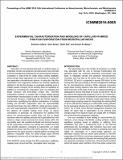| dc.contributor.author | Adera, Solomon | |
| dc.contributor.author | Antao, Dion Savio | |
| dc.contributor.author | Raj, Rishi | |
| dc.contributor.author | Wang, Evelyn | |
| dc.date.accessioned | 2019-02-11T17:53:10Z | |
| dc.date.available | 2019-02-11T17:53:10Z | |
| dc.date.issued | 2016-07 | |
| dc.identifier.isbn | 978-0-7918-5034-3 | |
| dc.identifier.uri | http://hdl.handle.net/1721.1/120326 | |
| dc.description.abstract | Generation of concentrated heat load in confined spaces in integrated circuits and advanced microprocessors has presented a thermal management challenge for the semiconductor industry. Compared to state-of-the-art single phase cooling strategies, phase-change based approaches are promising for cooling the next generation microelectronic devices. In particular, thin-film evaporation from engineered surfaces has received significant attention in the last few decades as a potential candidate since it enables passive transport of the working fluid via capillarity in addition to increasing the evaporation area via extending the liquid meniscus and three-phase contact line. Thin-film evaporation, however, is coupled with nucleate boiling making experimental characterization as well as modeling of the fluidic and thermal transport a challenging task for thermal engineers. Furthermore, quantifying the relative contributions of nucleate boiling and thin-film evaporation from the experimentally reported heat fluxes has been difficult. Unlike previous studies, our work experimentally characterizes thin-film evaporation in the absence of nucleate boiling from arrays of silicon micropillars. In particular, we characterize the capillary-limit where the microstructured surface dries out due to liquid starvation when the capillary pressure that is generated due to the meniscus shape cannot overcome the viscous losses within the micropillar wick. We modeled the fluidic and thermal transport of the evaporating meniscus by solving the coupled heat and mass transfer equations. Compared to experiments, our model predicts the dryout heat flux with ±20% accuracy. The insights gained from this study provide a suitable platform to design and optimize micropillar wicks for phase-change based thermal management devices such as heat pipes and vapor chambers. | en_US |
| dc.description.sponsorship | National Science Foundation (U.S.). Graduate Research Fellowship (Grant No. 1122374) | en_US |
| dc.description.sponsorship | United States. Office of Naval Research | en_US |
| dc.description.sponsorship | Singapore-MIT Alliance. Low Energy Electronic Systems Program | en_US |
| dc.publisher | ASME International | en_US |
| dc.relation.isversionof | http://dx.doi.org/10.1115/ICNMM2016-8085 | en_US |
| dc.rights | Article is made available in accordance with the publisher's policy and may be subject to US copyright law. Please refer to the publisher's site for terms of use. | en_US |
| dc.source | ASME | en_US |
| dc.title | Experimental Characterization and Modeling of Capillary-Pumped Thin-Film Evaporation From Micropillar Wicks | en_US |
| dc.type | Article | en_US |
| dc.identifier.citation | Adera, Solomon, Dion Antao, Rishi Raj, and Evelyn N. Wang. “Experimental Characterization and Modeling of Capillary-Pumped Thin-Film Evaporation From Micropillar Wicks.” ASME 2016 14th International Conference on Nanochannels, Microchannels, and Minichannels (July 10, 2016). | en_US |
| dc.contributor.department | Massachusetts Institute of Technology. Department of Mechanical Engineering | en_US |
| dc.contributor.department | Massachusetts Institute of Technology. Institute for Data, Systems, and Society | en_US |
| dc.contributor.mitauthor | Adera, Solomon | |
| dc.contributor.mitauthor | Antao, Dion Savio | |
| dc.contributor.mitauthor | Raj, Rishi | |
| dc.contributor.mitauthor | Wang, Evelyn | |
| dc.relation.journal | ASME 2016 14th International Conference on Nanochannels, Microchannels, and Minichannels | en_US |
| dc.eprint.version | Final published version | en_US |
| dc.type.uri | http://purl.org/eprint/type/ConferencePaper | en_US |
| eprint.status | http://purl.org/eprint/status/NonPeerReviewed | en_US |
| dc.date.updated | 2019-01-10T15:05:57Z | |
| dspace.orderedauthors | Adera, Solomon; Antao, Dion; Raj, Rishi; Wang, Evelyn N. | en_US |
| dspace.embargo.terms | N | en_US |
| dc.identifier.orcid | https://orcid.org/0000-0002-0258-0745 | |
| dc.identifier.orcid | https://orcid.org/0000-0003-4165-4732 | |
| dc.identifier.orcid | https://orcid.org/0000-0001-7045-1200 | |
| mit.license | PUBLISHER_POLICY | en_US |
